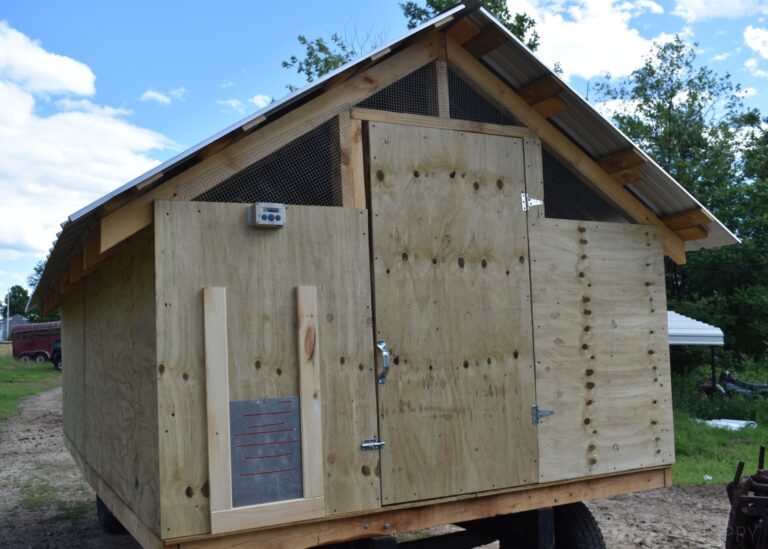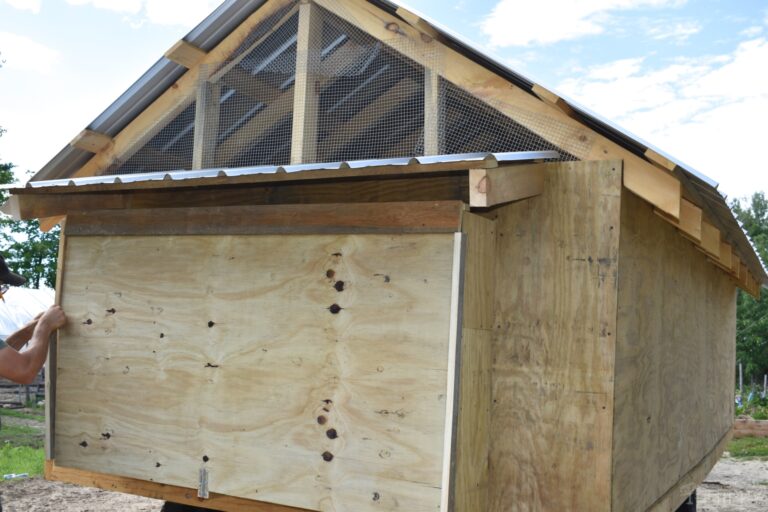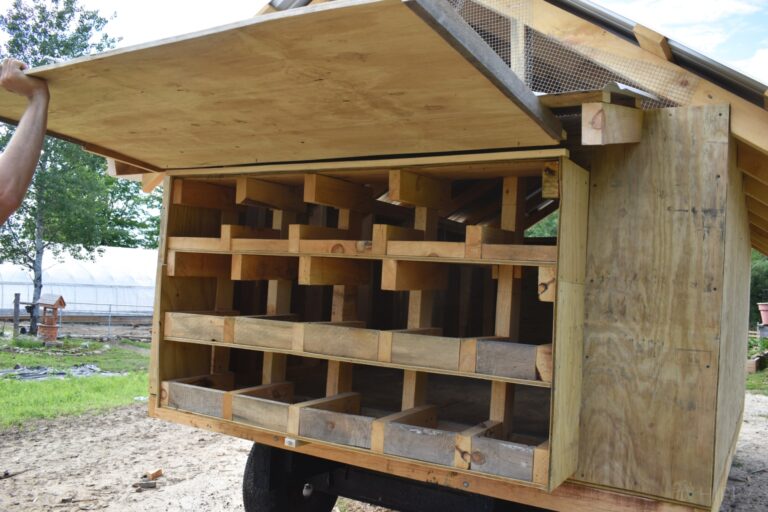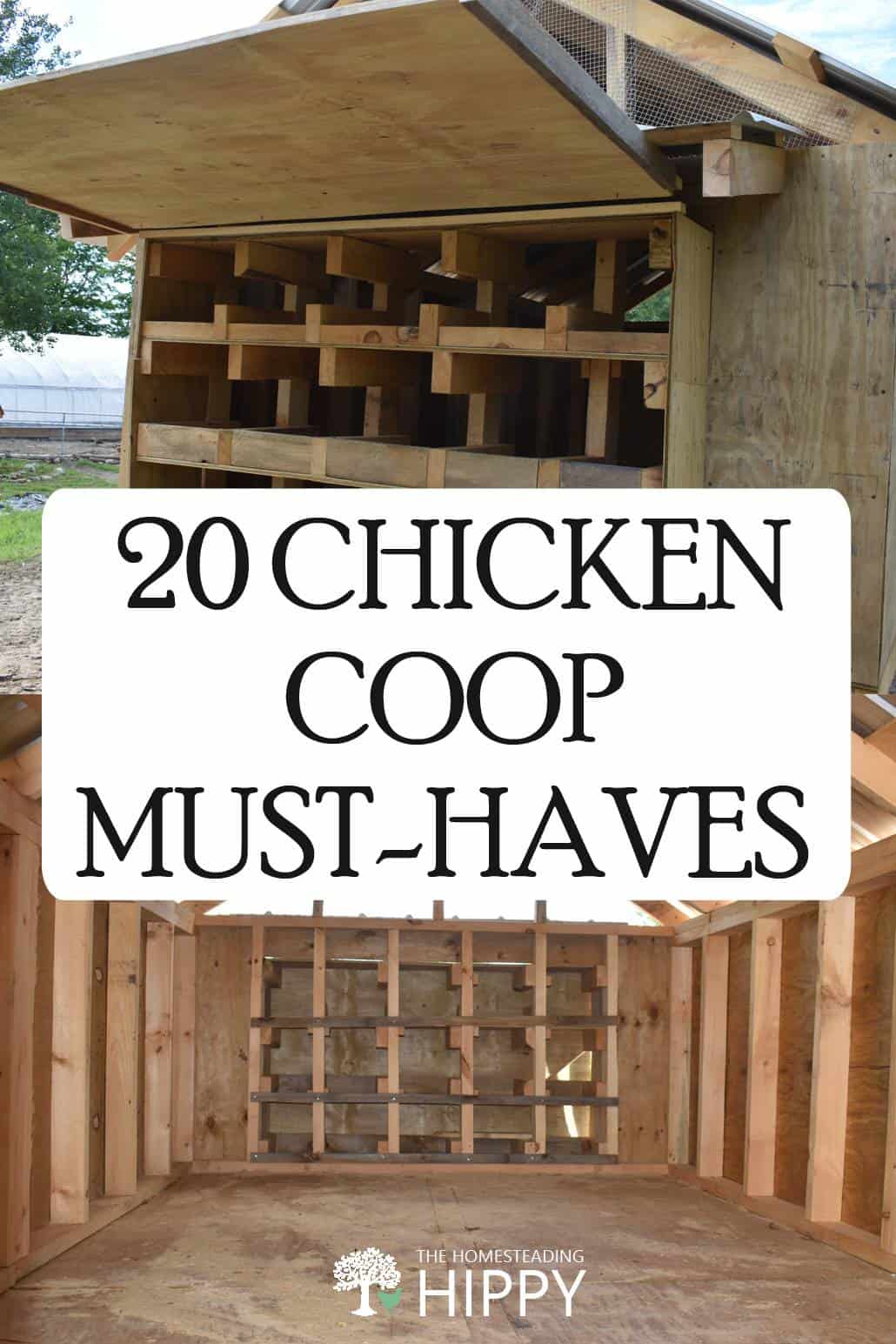It doesn’t matter whether you plan on raising five chickens or fifty – it’s essential that you outfit your coop with the right gear.
The ideal chicken coop will not only be safe from predators, but it will also be easy for you to access. It will ensure that your flock can remain happy and healthy throughout all of the four seasons.

Sounds pretty simple, right? Well, unfortunately, knowing exactly what it takes to set up a safe, productive chicken coop isn’t as easy as it sounds.
Chickens are pretty basic creatures, but you still need to do your due diligence to make sure they have what they need to thrive.
This spring, my husband built a brand-new chicken coop for our flock of 70 laying hens.
It’s much fancier than the one we had in the past, equipped with nest boxes that can be accessed from the outside and a pop-up door so we don’t have to go out every night and lock the birds in.
It’s the Ritz Carlton of chicken coops if you ask me (see above)…
When you’re building a chicken coop, there are a few features you’ll want to include – and some you may decide to toss in as an added benefit to your birds! These chicken coop must-haves will keep your birds happy, healthy, and productive.
1. Protection from Predators
Not to sound too morbid, but your chickens aren’t going to last long if they’re constantly being harassed by predators.
You’ve got to make sure your chicken coop has adequate protection from predators. Remember that all of the following creatures will go after chickens if they’re in the mood:
- Weasels
- Foxes
- Skunks
- Coyotes
- Dogs
- Cats
- Hawks
- Owls
- Bears
- Raccoons
…and many more!
Therefore, to prevent these predators, you need to think like them. Ask yourself, “If I were a skunk, how would I get inside this coop?” And then take appropriate steps to seal up any cracks, gaps, or openings in the coop.
You can use hardware cloth, for starters, to seal up any openings in the coop. Remember to seal up even small holes, as rats and weasels are quite adept at squeezing through small holes.
If you use hardware cloth, you’ll still be able to add ventilation to your coop without having to worry about pests sneaking in.
Chicken wire will not cut it. Although chicken wire is an effective way to keep your chickens where they need to be, it isn’t the best at keeping other predators out.
Raccoons, in particular, have been known to twist apart chicken wire and they won’t hesitate to pull your chickens through. Make sure everything is totally pry-proof!

2. Proper Ventilation
Good ventilation is also key in a chicken coop. You need to have a well-ventilated coop to eliminate moisture and reduce heat.
Note that I didn’t include the need for a heater or a fan on this list. Some people will include these features in their coops, but in my opinion, neither is necessary (and can actually prove to be dangerous).
Why, you might ask?
A heater will make it harder for a chicken to acclimate to outdoor temperatures. Chickens are already equipped with the natural measures they need to shake the cold.
Both heaters and fans can overheat and cause a fire, especially when they’re knocked over. They aren’t worth the risk.
To remedy both a chicken coop that is too hot and one that is too cold, good ventilation is key. In the winter, your chickens can suffer from frostbite if your coop is not ventilated properly.
Moisture will collect from the breath of your chickens and can make your birds sick. Closed-up coops are more problematic than dry coops.
Some tips?
You don’t necessarily want wind and drafts getting into your coop, but you do need to add enough ventilation to remove the moisture.
Put ventilation on the upper portions of the coop (you can use a louver, for example, or a ventilated ridge). The air will rise and depart through these upper ventilation systems.
Try to avoid too much ventilation down low, where your chickens will roost, as the drafts can make them chilly.
3. Lighting
You may want to add some supplemental lighting during the winter months. Light will help your chickens know where to come home to roost and it can also keep them laying during the darkest days of winter.
4. Roosting Bars
The average chicken needs about 12 inches of roost space. You’ll want a bit of space between your roosts (about 18 inches or so). Plan your coop accordingly!
Not only will adequate roosting space prevent squabbles among the birds in your flock, but it will help your chickens stay warm in the winter, too (they will huddle together and hunker down, covering their feet).
You can buy store-bought roosting bars, but the easiest solution is to just make some out of old logs or beams.
5. Bedding
Make sure you fill your chicken coop with plenty of fresh, clean bedding.
If you use the deep litter method of bedding your coop, you only need to replace the bedding once or twice a year (but you should still add another layer of bedding every week or so).
Otherwise, make it a point to scrape out your chicken coop and add fresh bedding once a week. Good options for bedding include:
- Sand
- Shredded newspaper
- Wood shavings (avoid cedar and other aromatic woods)
- Straw
- Hay
- Grass clippings
- Leaves
6. Nesting Boxes

Chickens will lay their eggs anywhere, but to make your life easier, you should build nesting boxes that are easy to access.
You will need at least one nesting box for every four to five birds or so (you may be able to get away with less space depending on your breed and how frequently they lay, although this is the recommended nesting box ratio in most cases).
The nesting boxes should be dark and quiet, located away from the roosts so they don’t get pooped in.
Fill the nesting boxes with plenty of clean, fresh bedding (we like to use a bedding type that is different from what we use in the rest of the coop so that it’s clear to the chickens where they need to lay their eggs).
7. Easy to Clean Features
A good chicken coop will also be easy to clean. Of course, no chicken coop will clean itself (although wouldn’t that be a handy design?), but if you design your chicken coop cleverly, you’ll be able to clean all the nooks and crannies.
Try to avoid too many odd corners and angles when you’re designing your coop, and make it so that as many features as possible can be removed for easy cleaning.
8. Non-Toxic Materials
Try not to use toxic materials, like treated wood, in areas where your chickens can peck or eat the material. You can use these in spots where your coop comes into contact with the ground to prevent rot, though. Good options for rot-resistant woods include hemlock and cedar.
9. Proper Sizing

For most standard chicken breeds, you need to supply a minimum of four square feet per bird in the coop (and more in the run). The more space, the better – and don’t forget that you’ll be adding roosting areas and nest boxes, too, so you don’t want to cut corners.
Too little space can result in chickens that are unhealthy and aggressive – chickens that feel crowded will engage in dangerous behaviors, like feather picking.
10. Dropping Pans
We don’t use dropping pans in our coop – these are optional, in my opinion. But putting some dropping pans out of things like corrugated polycarbonate roof panels can make your cleaning chores a bit easier.
They’re a good option if you want to keep an eye on things like parasites or coccidiosis in your chickens’ feces.
11. Fencing
Don’t forget to include some secure fencing around your coop. Our chicken coop is positioned inside our sheep paddock, so we already had a fence built.
You need something strong enough to keep your chickens in, and predators out. Electric fencing can work, and so can hardware cloth, but we used page wire since we already had it in place.
12. Food Storage Containers
We have a few food storage containers that we keep outside in the pen to help reduce the amount of food we have to haul outside each day.
We use large food-grade drums for this purpose. They can be sealed and rats and mice can’t chew through them. Plus, you won’t have to worry about the food getting wet and ruined.
13. Dust Bathing Areas
Chickens need to roll around in dust baths every now and then! If your chickens have access to pasture or a run where they can dust bathe, you do not need to include this feature inside your coop.
But if they don’t, or are locked inside for much of the day, put a pan of dirt (and fresh herbs if you want to add a dose of parasite-busting benefits!) inside the coop.
14. Diatomaceous Earth
Diatomaceous earth is a helpful tool that can keep your chicken coop healthy. Not only can it get rid of lice and mites in the coop, but it can also help with the smell. It’s safe for chickens and can be dusted around the coop as needed.
15. Feeders
Chickens need to eat! The feeder you use will depend on the flock size you have – and how often you want to fill your feeders.
We have large troughs that are filled once a day, a necessity when feeding 70 chickens. However, if you only have a few chickens, you may only need to feed them a few times per day.
Ideally, choose a feeder that is hard for your chickens to stand in – they’ll poop inside and kick in soiled bedding. This can lead to food waste and also to diseases. I like hanging feeders the best, as they are impossible for your chickens to sully.
16. Treats
Feel free to add treats to your chicken coop from time to time (although I wouldn’t recommend more often than once per day). There are all sorts of treats you can feed your birds, from mealworms to cabbage heads.
I recommend feeding in a separate pan or hanging the treats from the ceiling of the coop – that way, your chickens won’t be eating off the ground and making a mess.
So what are some of the best treats to give to your chickens? Good options include:
- Carrots
- Kale
- Watermelon
- Mealworms
17. Waterers
We have a few five-gallon water troughs that we use in our coop, which works well for large flocks of chickens.
You can also set up an automatic drinker system with nipples to make your life a little easier (the chickens can easily be trained to drink out of the nipples) or fill watering troughs more frequently.
It’s up to you, but make sure you have plenty of watering areas in your coop and run, especially if you have lots of chickens or if you have a large run. Believe it or not, chickens can sometimes forget to drink, especially if they happen to forget where their waterers are located.
18. Supplement Dispenser / Trough
There are several supplements chickens might need, and supplying them in a dispenser or through specifically for this purpose is an easy way to keep your coop clean, and make sure your chickens are getting everything they need.
Some people feed their chickens grit – if your chickens are free ranging or have access to pasture, they probably don’t need this. However, chickens that are being raised full-time in a coop need grit to help them digest their food.
Calcium is essential, too. We use a separate feeding trough for our calcium (oyster shells) – you could also hang a dispenser on the wall. Your chickens will help themselves whenever they need it – you don’t have to worry about them overdoing it.
19. Automatic Chicken Coop Door Opener

After installing an automatic door on my chicken coop a few years ago, I will never go back to the alternative.
If you don’t have an automatic door, you will have to go out to the coop every night to lock up your flock. This can be incredibly frustrating, especially if you’re away from home in the evenings.
Automatic coop doors can be programmed to open and close at certain intervals. You can program them to the rising and setting of the sun, or to a certain time of day.
Your chickens will go inside, the door will shut, and there will be no more chicken chasing at all hours of the night!
20. “Boredom Busters”
Our chickens free-range, both in the summer and winter months, so we don’t have any boredom busters in our coop. Lots of people do, though. You can include all kinds of boredom busters in your coop.
Here are a few options:
- Chicken swing
- Jingle bells
- Pinatas
- Logs and perches
- Hanging snacks
- Pumpkins
- Treat wreaths
- Rolling bottles
- Frozen treats
21. A Chicken Run
A chicken run is an essential part of any chicken coop. It allows chickens to stretch their legs and get some exercise, while also providing them with a safe place to forage for food.
A chicken run should be large enough to comfortably accommodate all of the chickens in your coop, and it should be enclosed on all sides to protect the chickens from predators.
The floor of the chicken run should be covered with a layer of sand or gravel to help prevent the spread of disease, and it should be equipped with a water source so that the chickens can stay hydrated.
22. Windows – or Another Way to Let the Sunlight In!
A chicken coop is not complete without a window. There are many reasons for this, but the most important one is that chickens need sunlight. Sunlight helps chickens to produce vitamin D, which is essential for their health.
Vitamin D helps chickens to absorb calcium, which is necessary for strong bones and feathers.
Additionally, sunlight exposure helps to prevent respiratory problems and increases overall immunity. In the winter months, when there is less daylight, a window can help to ensure that your chickens are getting enough sun.
23. Shade Cloth
Shade cloth is an often overlooked but important part of chicken coop design. Chickens are susceptible to heatstroke, so it’s important to make sure they have access to shady areas where they can escape the sun.
Shade cloth can also help to keep the coop cooler in general, which can be a lifesaver on hot summer days.
How Big of a Coop Do I Need for 12 Chickens?
If you’re planning to keep chickens, one of the first questions you’ll need to answer is how big of a coop you’ll need.
It’s important to consider the coop necessities, as described above, but you also need to make sure you have room to store all of this gear without overcrowding your backyard birds!
The size of the coop will be determined by the number of chickens you plan to keep and the breed of chicken.
For example, bantam breeds will require less space than standard breeds. In general, you can expect to need about 3-4 square feet per chicken. So, for a flock of 12 chickens, you would need a coop that is at least 36 square feet.
However, it’s always better to err on the side of caution and go with a larger coop. This will give your chickens plenty of room to move around and stay comfortable.
There you have it! Everything you need in your chicken coop to keep your birds happy and healthy. Whether you’re building a new coop or upgrading the one you already have, don’t forget these features to help your birds thrive.


Rebekah is a full-time homesteader. On her 22 acres, she raises chickens, sheep, and bees, not to mention she grows a wide variety of veggies. She has a huge greenhouse and does lots of DIY projects with her husband in her ever-growing homesteading endeavor. Learn more about Rebekah here.

Enjoyed your informative article. Thank you. I have one question; in your article you referenced “per day” a couple of times. The last was in giving treats once per day. Is the per day correct or maybe a “typo”?
Mike
Appreciate your list, but find it frustrating that once again, “well ventilated” is offered as the solution to a coop with too much moisture. While I completely agree that ventilation is critical, I don’t see how even the best ventilation will help control moisture in the coop in damp climates. For example, I live in the PNW, where winter temperatures are in the 20s and 30s, cold enough for frostbite, with outdoor humidity in the 95-100% range on most days. Winter is our rainy season (all 8 months of it). My 8 x 8 shed-style coop is ventilated with 3 windows (which are only cracked during the winter when temps are above freezing), eave vents on both ends, and ridge venting. There is no water kept in the coop, and droppings are removed from sand-filled dropping trays daily. The floor is covered in 4-6” of hemp bedding, which is sifted regularly. Still, there is frequently condensation on the windows, walls, and ceiling. What tips can you or your expert affiliates offer for keeping a coop “dry” in these types of climate conditions?
Not an expert here, but maybe a dehumidifier? It’s not a perfect solution, obviously, but maybe it will help?
Hey! I really enjoy your content. I am new to raising chickens, I have 12 in my brooder right now. We have an old structure in great condition that I’d like to use for our coop. It has a window, and I will put in all the essentials, I am wondering if the chickens are going to free range, and I put an automatic door on it, do I need to build them an outdoor enclosed area as well? Or will their chicken shack suffice as long as they can go outdoors during the day?
If you want to still have chickens by the end of the day, yes, they need an outdoor enclosed area.
I recently went from 25 chickens down to eleven, because our main enclosure had a covering failure after a pair of heavy snows, and when I removed it, the remaining chickens – including three adult roosters – disappeared over the course of the next three or four weeks.
There are a lot more predators out there than you may realize.
Good luck.
Clarification: when I removed the covering, which consisted of bird netting.
We had already lost a Svart Hona rooster, previously; and lost a hen in the second heavy snow, which trapped her atop a rabbit cage, and evidently suffocated her.
I initially thought I’d lost two hens, but her sister turned out to be okay, only to disappear later, after I removed the cover.
The walls of the enclosure remained, but the weight of the snow pulled the fence posts severely toward the center, so whereas theffy started out at four feet tall, one side was closer to 18″ by the end.
Since there were never any remains, other than feathers, I believe that most, if not all, were taken by foxes.
The chickens that survived were in two separate, fully-enclosed coops.
Loved all of this! We are new to being Chicken “Parents”…. and actually just going to be picking up my chicks this week. Still finishing up the run… and getting the brooder ready for babies. Cannot wait to find more of your videos on line. Thank you! ?
Pam
My grandparents had chickens ? the entire time we was growing up. Oh boy if some things have truly changed. My husband and I have raised chickens, ducks, and turkeys. We enjoy teaching others what we have learned and love finding out new ideas. Thank you for posting this article I’ve learned a lot more ideas for in our run and coop.
Seems like you’re using coop as general term. A coop is the building that houses the chickens and then you have the run which is the fenced in portion
Yep, I suppose things like boredom busters are most often placed in the run, not the coop – unless you have a really big coop!
If you don’t have a closed coop, how do you keep the water from freezing in the winter?
Can I use a plastic tool shed as a coop? It has vents and I can put in a window or two. We do get snow in the winter and they will have a good run for the summer months. Just not sure how it will compare to a wooden coop.